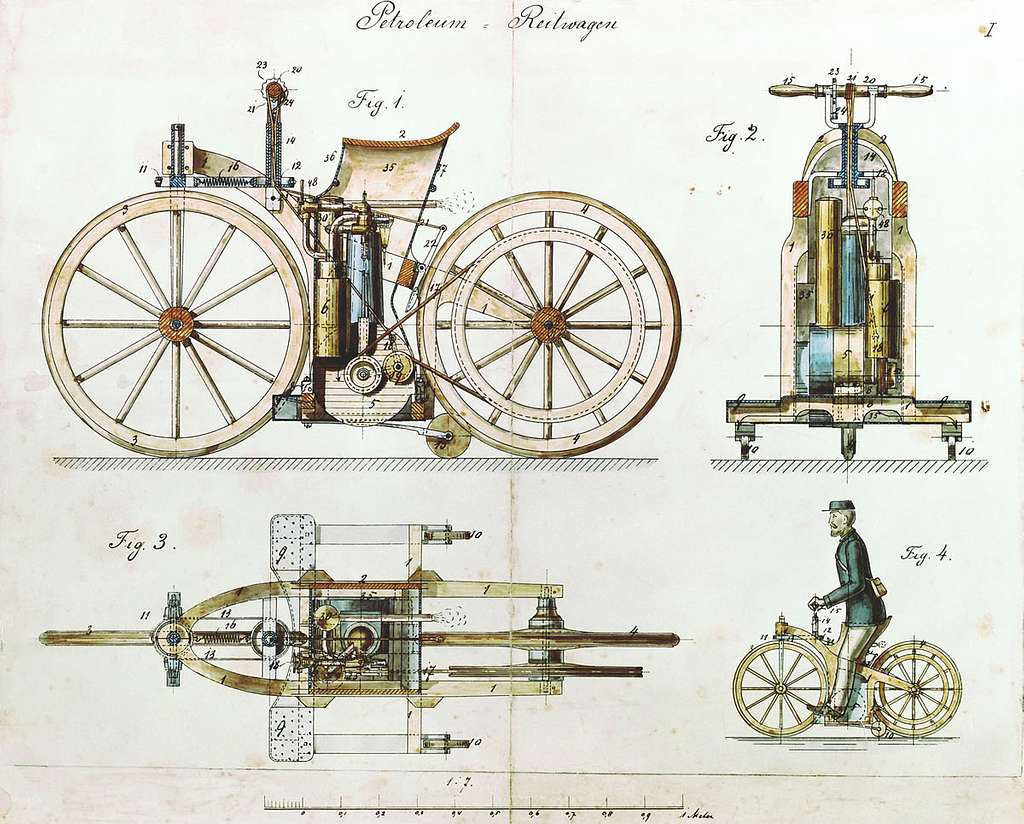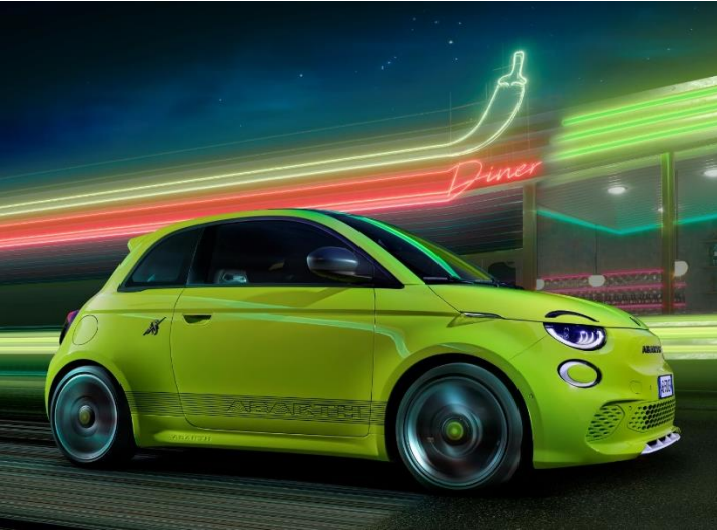Today marks the anniversary of German engineer Gottlieb Daimler unveiling the world’s first motorcycle. The Daimler Reitwagen or the ‘riding cycle’. The motorcycle, which is also known as Einspur or ‘single track’, was a motor vehicle made by Daimler with Wilhelm Maybach in 1885. Having made the first Motorcycle Daimler is often also called the ‘father of the motorcycle’.
The Father of the Motorcycle
Early Years
Gottlieb Wilhelm Daimler was the son of a baker named Johannes Däumler (Daimler) and his wife Frederika. By the age of 13 (1847), he had completed six years of primary studies in and became interested in engineering.
After completing secondary school in 1848, Daimler had trained as a gunsmith under Master Gunsmith Hermann Raithel until he ended training in1852. The same year, at eighteen, Daimler decided to take up mechanical engineering and left his hometown.
Daimler enrolled at Stuttgart’s School for Advanced Training in the Industrial Arts, under the tutelage of Ferdinand von Steinbeis. In 1853, Daimler, with Steinbeis’ assistance, got work at “the factory college”, Rollé und Schwilque (R&S) in Grafenstaden. Daimler performed well, and when Rollé und Schwilque began making railway locomotives in 1856, Daimler, then 22, was named foreman.
Instead of staying, Daimler took two years at Stuttgart’s Polytechnic Institute to hone his skills, gaining in-depth understanding of steam locomotives. He is quoted as having “a profound conviction” steam was destined to be superseded. He conceived small, cheap, simple engines for light industrial use.
Visit to England
In 1861, he resigned from R&S, visiting Paris, then went on to England, working with the country’s top engineering firms. He spent from autumn 1861 to summer 1863 in England, which was then regarded as “the motherland of technology. While in London, he visited the 1862 International Exhibition, where one of the exhibits was a steam carriage. This steam carriage he saw as un-inspiring, however, this motivated him more to make a small, cheap and simple engine.
The Final Spark in the Engine
Daimler studied engineering at the Stuttgart polytechnic institute and then worked in various German engineering firms, gaining experience with engines. In 1872 he became technical director in the firm of Nikolaus A. Otto, the man who had invented the four-stroke internal-combustion engine.
A Timeline of the World’s First Motorcycle
The Otto four-stroke engine (1876)
In 1872 at age 38, Daimler and Maybach moved to work at the world’s largest manufacturer of stationary engines at the time. This being the Deutz-AG-Gasmotorenfabrik in Cologne. It was half-owned by Nicolaus Otto, who was looking for a new technical director.
In 1876, Otto developed a gaseous fuel, compressed charge four-stroke cycle engine after 14 years of effort. A system characterized by four piston strokes (intake, compression, power, and exhaust). Otto intended that his invention would replace the steam engines that were predominant in this era.
Otto’s engine was patented in 1877, but one of his 25 patents was soon challenged and overturned. Daimler, who wanted to make his own engine, feared Otto’s patent would prevent it. Daimler hired an attorney who found that a prior art patent for a four-stroke engine had been issued in Paris in 1862.
Meanwhile, serious personal differences arose between Daimler and Otto, Daimler wanted to build small engines that could be applied to transportation but Otto had no interest in this. When Otto excluded Daimler from his engine patents there was great animosity between the two. Daimler was fired in 1880, receiving 112,000 Gold marks in Deutz-AG shares in compensation for the patents of both Daimler and Maybach. Maybach resigned later and followed Daimler.
Independent Inventor of small, high speed engines, 1882
At Cannstatt, Daimler and the more creative thinking Maybach devised their engine. At Daimler’s insistence, it eliminated “the clumsy, complicated slide-valve ignition” in favour of a hot tube system.
In the summer of 1882, Daimler moved to Cannstatt with 75,000 Gold marks from the compensation from Deutz-AG. Maybach followed in September of that year. In the garden, they added a brick extension to the roomy glass-fronted summer house which became their workshop. Their activities alarmed the neighbours who reported them to the police as suspected counterfeiters. The police obtained a key from the gardener and raided the house in their absence, but found only engines.
Daimler and Maybach spent long hours debating how best to fuel Otto’s four-stroke design, and turned to a commonly available petroleum fraction. The main distillates of petroleum at the time were lubricating oil, kerosene and ligroin. At this point in time these ingredients were readily available at most pharmacies.
The Dream engine 1883
In late 1883, Daimler and Maybach patented the first of their engines fuelled by ligroin. This engine was patented on 16 December 1883. It achieved Daimler’s goal of being small and running fast enough to be useful at 750 rpm. Improved designs in the next four years brought that up to 900 rpm. Daimler had three engines built to this design early in 1884, and a flywheel was included in one of the engines. This design was smaller and lighter than engines by other inventors of the time.
The 1885 Grandfather clock engine
The engine with the flywheel included was built into a light vehicle. This vehicle was called the Reitwagen, the world’s first vehicle powered by an internal combustion engine.
It took considerable effort and experimentation, but eventually, the duo perfected a .5 hp (0.37 kW; 0.51 PS) vertical single. This engine was fitted in the Reitwagen, a purpose-built two-wheeler chassis with two spring-loaded stabilizers. Features of the 1885 Engine included:
- a single horizontal cylinder of 264 cc, 16 cu in (58 mm × 100 mm, 2.3 in × 3.9 in)
- air cooling
- large cast iron flywheel
- surface carburetor
- hot tube ignition system
- cam operated exhaust valves, allowing high speed operation
- 0.5 hp (370 W)
- 600 rpm running speed, beating previous engines, which typically ran at about 120 to 180 rpm
- weight of around 50 kg (110 lb)
- height of 76 cm (30 in)
In 1885, they created a carburettor which mixed gasoline with air allowing its use as fuel. In the same year Daimler and Maybach assembled a larger version of their engine. It now had a vertical cylinder of 100 cc displacement and an output of 1 hp at 600 rpm. It was baptized the Standuhr (“grandfather clock”), because Daimler thought it resembled an old pendulum clock.
The World’s First Motorcycle
In November 1885, Daimler installed a smaller version of the grandfather clock engine in a wooden two-wheeler frame with two outrigger wheels, creating the first internal combustion motorcycle. It was named the Reitwagen (riding car). Maybach rode it for three two miles alongside the river Neckar, from Cannstatt to Untertürkheim, reaching speeds of 7 mph.
Was it really the first motorcycle?
The Reitwagen‘s status as the first motorcycle rests on whether the definition of motorcycle includes having an internal combustion engine. The Oxford English Dictionary uses this criterion. Even by that definition, the use of four wheels instead of two raises doubts. If the outriggers are accepted as auxiliary stabilizers, they point to a deeper issue in bicycle and motorcycle dynamics. This being that Daimler’s testbed needed the training wheels because it did not employ the then well-understood principles of rake and trail.
For this and other reasons motoring author David Burgess-Wise called the Daimler-Maybach “a crude makeshift”, saying that “as a bicycle, it was 20 years out of date. “Cycle world’s Technical Editor Kevin Cameron, however, maintains that steam power was a dead end and the Reitwagen was the first motorcycle because it hit upon the successful engine type. He continued to say that “History follows things that succeed, not things that fail.”
Enrico Bernardi’s 1882 one-cylinder gasoline-engined tricycle, the motrice pia is considered by a few sources as the first gasoline internal combustion motorcycle. In fact the first ever internal combustion vehicle. Bernardi mounted his engine on the bicycle of his son. Dailmer designed and built the Reitwagen chassis to fit the needs of his machine and so is dubbed the first all around motorbike. The Motrice Pia is not mentioned in any mainstream sources. There is also some discussion in mainstream sources that merit the Michaux-Perreaux steam velocipede or Roper steam velocipede as the first motorcycle.
Summary
Today marks the anniversary of German engineer Gottlieb Daimler unveiling the world’s first motorcycle, the Daimler Reitwagen or the ‘riding cycle’ in 1885.
By the age of 13 Daimler had already become interested in engineering so decided to pursue a career as a gunsmith until 1852 when he decided to leave his hometown and become a mechanical engineer. It was during these years the Daimler first became interested in engines. It was between 1876 and 1885 that Daimler created a number of engines such as the Otto four-stroke engine, Dream engine and finally the Grandfather clock engine which was put into the worlds first motorcycle.
The Reitwagen‘s status as the first motorcycle has been queried by a number of people who believe themselves to have made the world’s first motorcycle. Enrico Bernardi’s 1882 one-cylinder gasoline-engined tricycle, the motrice pia is considered by a few sources as the first gasoline internal combustion motorcycle. There are also some who merit Michaux-Perreaux’s steam velocipede or Roper steam velocipede as being the first motorcycle.
In mainstream media, however, Daimler’s Reitwagen is credited as being the worlds first motor cycle and for pioneering the engines that shape the world we live in today.





